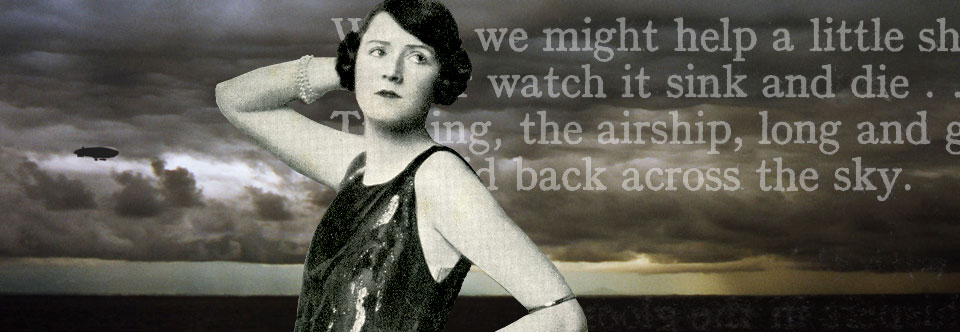
While every story doesn’t need a love interest, they are always interesting when one finds one. In the case of airship NS11 this is provided by Pansy Nina Grahame Chambers, together with a fair dose of intrigue, unsolved questions and an astonishing coincidence.
Born in Holywood, Dunfriesshire, Scotland in 1898, Pansy’s parents were Major William Graham Chambers (formerly William Goulay Dunn and from a famous golfing family) and Nina Grace Chambers (the publishing family). By the time she was three, Pansy and her parents were living at Glenbrittle Lodge, Minginish on the Isle of Skye. The family travelled to Canada in 1911, living on Vancouver Island, before returning to London in 1915. Pansy had three brothers, Robert Laing Chambers (a trooper of the 1st Australian Light Horse who was killed in action at Gallipoli on 18 May 1915) and Murray Goulay Chambers, and a sister, Nina Iris Grahame Chambers.
The next we hear about Pansy is in the 29th November 1917 edition of Flight magazine…
The engagement is announced of WALTER KEMEYS FRANCIS GOODALL WARNEFORD, Flight Commander, R.N.A.S.. son of Mr. and Mrs. Walter Warneford, of Lansdowne House, Huyton, Lancs, to PANSY GRAHAME CHAMBERS, daughter of captain W. Graham Chambers, late Gordon Highlanders, Canada, now Lieutenant-Commander, R.N., and of Ardmay, Arrocha.
Walter and Pansy didn’t marry. On 15 July 1919, however, the very day NS11 was lost and Walter Warneford and his crew were killed, Pansy married Patrick Gream Nelson Ommanney at the Holy Trinity Church, Brompton, London. At the time of the marriage Patrick was a Major in the RAF, ex-Lieutenant, RN and former commander of the rigid airship R27. The airship flew 89 hours 40 minutes under Ommanney’s command, but came to a disastrous end when she was destroyed by fire together with SSZ.38 and SSZ.54 on 16th August 1918.
Patrick was son of the highly-regarded RN Rear Admiral, Sir Robert Nelson Ommanney. Sir Robert was appointed a Knight Commander of the Military Division of the Most Excellent Order of the British Empire (K.B.E.) on 1 January, 1919. All this might be significant as Patrick would certainly make a ‘better match’ for Pansy than Walter Warneford, son of a railway engineer.
Significantly, also at the church that the day of Pansy and Patrick’s wedding was Edward M. Maitland, Brigadier General of the RAF and head of the airship service who had returned from the USA to Pulham aboard R34 just two days before. His signature is written on the margin of the wedding certificate.
There is no doubt that NS11’s commander on the night she was lost was well aware that the girl he was engaged to, announced a little more than a year and a half before, was to be married to another man that day. Whether this has any significance, or is just an incredible coincidence, will probably never be known.
Something of an inventor, Pansy’s new husband, Patrick Ommanmey is granted a patent on 5 May 1920 for an “instrument for facilitating calculations depending on the relations between the pressures, densities, temperatures and percentage compositions of gases, and the recording of observations of these quantities.” It then looks like Patrick spends most of the 1920s travelling back and forth to the USA, as first a journalist and then as a merchant (possibly for tea and coffee).
We know Pansy was an artist and a poet – probably from a young age. Her verses were published in The Tatler, Sphere, Windsor Magazine, Chambers’ Journal and London Mercury. Much in the same style as the poetry of well-known airship advocate Dame Sybil Grant, a collection of Pansy’s poetry was published in a book called Tunes On A Barrel-Organ in the 1920s. As well as poems of love and loss as might be expected, there is one poem with a strong airship theme…
We! (A Forecast)
We are the pride of nations
(The world stands by to gaze),
Fearing our power and wondering,
They watch us on our ways.
Silent our strength, untried as yet,
Though we may light world fires :
Questing we ride the elements,
The winds hiss through our wires.
O little ships of ancient days
We watch you down below,
Trade is our job, but war a game
We somehow seem to know.
Where we might help a little ship,
Or watch it sink and die…
Turning, the airship, long and grey,
Slid back across the sky.
T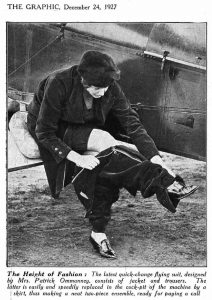 here was more to Pansy than art and poetry. On 24 December 1927 and interesting piece appears in The Graphic. It shows Pansy demonstrating her design of a “quick-change flying suit”. Another photo from this demonstration appears in The Sphere of 18 February 1928…
here was more to Pansy than art and poetry. On 24 December 1927 and interesting piece appears in The Graphic. It shows Pansy demonstrating her design of a “quick-change flying suit”. Another photo from this demonstration appears in The Sphere of 18 February 1928…
THE DESIGNER OF A VERY MODERN FROCK
Mrs Patrick Ommanney, a skilled pilot, in the costume she has designed specially for flying. This can be transformed in the cockpit of a ‘plane from a trousered creation into a luncheon frock with skirt complete.
News of Pansy and her flying suit travelled the world. On 4 February 1928 interesting appears in the Wellington Evening Post [NZ].. 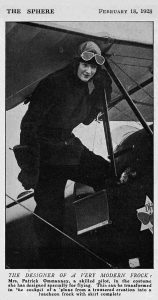
A NEW FLYING FASHION
A novel quick-change flying suit, designed by Mrs. Patrick Ommanney, in a dark blue cord, which enables the wearer to perform a quick-change in the cockpit of the airplane while flying, and so be ready to take part in any social function, etc., on landing. Mrs. Ommanney is here seen in her quick-change suit, standing by her airplane ready for flight.
And in the Adelaide Advertiser of 23 January 1928…
While we have yet to determine if Pansy had a pilot’s licence, there is some evidence she could fly an aircraft although there is no record she owned her own aircraft. In an as yet undated newspaper clipping (but probably around 1928) we find Pansy was making her name in the world of fashion…
Mrs. Pansy Ommanney, poetess, explorer, and dress designer. As a dress designer she is making an international reputation, and her frocks are being worn by the smartest people.
In the 1920s Pansy had her own fashion business called House of Itylus at 149 Bond Street, London.
In 1929 Pansy and Patrick divorce.
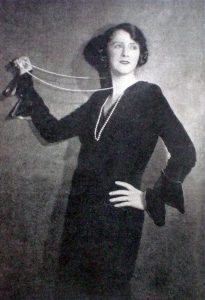 On 12 September an announcement is made in the London Gazette…
On 12 September an announcement is made in the London Gazette…
Notice is hereby given that on the 29th day of August, 1930, PANSY NINA GRACE Chambers, of 118 Park-street, in the county of London, heretofore since the date of her marriage with Patrick Gream Nelson Ommanney, called and known by her name of Pansy Nina Grace Ommanney, renounced and abandoned the use of her said surname of Ommanney and resumed her maiden name of Chambers; and further that such change of name is evidenced by a deed dated 29th of August, 1930, duly executed by her, and attested and enrolled in the Enrolment Department of the central Office of the Royal Courts of Justice on the 8th day of September, 1930. dated the 8th day of September, 1930. GORDON DADDS and CO, 11-12, St James’-place, London, S.W.1.
At St. Giles Church, Edinburgh on 8 December 1930 Pansy married Perceval Anthony Thomas Hildebrand Harmsworth son of Sir Hildebrand Aubrey Harmsworth.
In August 1939 Pansy had an article on canal cruising published in Chambers Journal. She wrote and broadcasted throughout the war and was given facilities as Air Correspondent by the Air Ministry.
Her relationship with Perceval Harmsworth was not perfect, however, as he was involved in a divorce case…
In this petition Mr. Philip Henry George Gosse, of Hills Road, Cambridge, sought the dissolution of his marriage with Mrs Irene Ruth Gosse on the ground of her adultery at Earl’s Terrace, Kensington, with Mr Perceval Antony Thomas Hildebrand Harmsworth, against whom the petitioner claimed damages. (£250 ordered to be paid within 14 days). The Times. 23 July 1941.
It seems Perceval stayed with Irene. From the London Gazette of 17 July 1942…
Notice is hereby given that IRENE RUTH GOSSE of Weppons, Steyning in the county of Sussex a natural born British subject, intends after the expiration of twenty-one days from the date of publication of this notice to assume the surname of Harmsworth in lieu of and in substitution for her present surname of Gosse. Dated this 14th days of July 1942.
Pansy and Perceval did divorce. Pansy continued to live at Kings Mead in Steyning, Sussex until late 1949, at which time she moved to Jamaica to teach art. She left Jamaica for Le Harvre, France in 1951 and moved to Guernsey.
In 1959 Pansy married Lieut Colonel George Hornung. A son of the Africa pioneer, sugar planter, businessman and horse breeder ‘Pitt’ Horning, George was wounded during the Great War, and subsequently commanded the Horsham Battalion of the Home Guard during the Second World War.
Pansy died in Guernsey on 17 April 1975.
We leave you with another of her poems…
A Maker Of Music
Life is the best of all our chances
Love the prize for which we break lances,
Death is the end of all our dances :
And of these three I weave romances.
Many thanks to Deb Fitzpatrick (Pansy was her great aunt), Teresa Stokes (Perceval Anthony Harmsworth’s cousin), Heather and David Henderson, Bernard Horning (George Horning was his great uncle) and David Tovey for providing invaluable detail on Pansy’s story. Thanks also to Paul Jackson for identifying the aircraft in the photographs (a DH.60 Moth owned by Christian Pittman at the London Aeroplane Club).

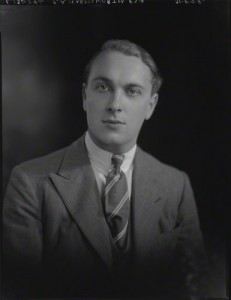
 NS11 – As Bright As Day is very much a work in progress and has been made possible by the generous and enthusiastic support of many individuals and organisations. If you have any information, records or material relating to British NS Class airships we would be very interested to hear from you – especially anyone related to members of the crew of NS11 or any airship of the class during their service with the RNAS or RAF during and beyond WWI.
NS11 – As Bright As Day is very much a work in progress and has been made possible by the generous and enthusiastic support of many individuals and organisations. If you have any information, records or material relating to British NS Class airships we would be very interested to hear from you – especially anyone related to members of the crew of NS11 or any airship of the class during their service with the RNAS or RAF during and beyond WWI.
Latest